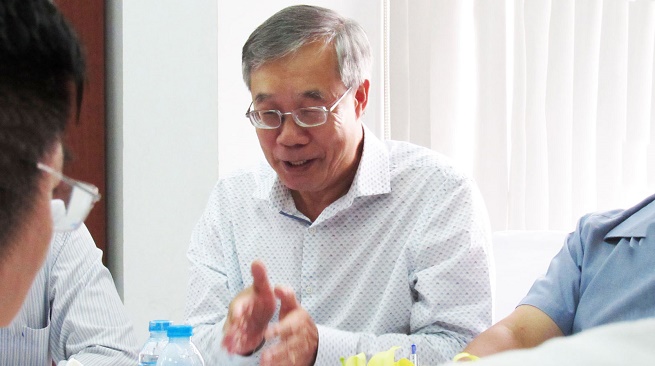The Goals of Education and the 4.0 Syndrome
During the seminar “High-Level Human Resources in the Digital Economy: Awareness, Competence, and Solutions” organized by TheLEADER last weekend in Ho Chi Minh City, the most debated topic was the “4.0 syndrome.”
According to education expert Tran Duc Canh, the goal of education is vast and encompasses all areas of society. The 4.0 revolution, or similar names, is one of the important conditions for socio-economic development, but it is only a part of the education and training content.
|
Mr. Tran Duc Canh was the former Director of Training and Human Resources Development for the state of Massachusetts (USA), a member of the Northeast Regional University Council, and served many years as an admissions advisor for Harvard University. He was appointed by Prime Minister Nguyen Xuan Phuc to the National Council for Education and Human Resource Development for the 2017 – 2021 term. Despite living abroad for more than four decades, he has always been concerned about domestic education issues, especially helping to connect US educational programs and scholarships with Vietnam. |

Education expert Tran Duc Canh sharing at the seminar on high-quality human resources in the digital economy organized by TheLEADER on August 26
“In basic education, there is no trend”
According to Mr. Tran Duc Canh, the foundation of Vietnam’s higher education system is currently not strong, and the system’s coherence is not high, risking shifting from one extreme to another.
“I have managed the human resource development department for a US state for many years but have never heard the term high-quality human resources, yet this term is very popular in Vietnam. Although the initial purpose was to distinguish, it is easy to misuse the terminology. It feels like the clean sugarcane juice stands, super clean, then super – super clean… until the term high or not loses its meaning.
Similarly, when we talk a lot about 4.0 technology or entrepreneurial spirit and want to incorporate it into secondary and higher education curricula. In the era of technology and integration, everything will change rapidly on its own; in basic education, content should not be built on phases or trends but should be comprehensive and long-lasting,” Mr. Canh analyzed.
Assessing Vietnam’s human resources, Mr. Canh said that from a macro perspective, about 48% of people aged 25 – 60 have not undergone vocational training, mostly in rural and mountainous areas; 23% are trained or retrained by businesses.
In total, over 70% of the labor force has been vocationally trained, with university and higher education levels not reaching 30%. The workforce trained at the college level and above accounts for only about 13%, while the OECD average is 35.7%, and South Korea is 46.9%.
“Not to mention quality, the percentage of workers trained at the college level and above is still very low compared to developed countries. The challenge is not only to train high-quality human resources but also in quantity at all levels and grades to successfully approach the knowledge economy and global integration,” Mr. Canh affirmed.
Moreover, according to this expert, the number of college and university graduates who are unemployed is not due to quantity but quality. Vietnam’s training cost for one student is about 700 USD/year; where does the quality come from when the minimum training cost for one student in the region is about 5,000 USD/year, while in the US, it is 19,000 USD/year.
Mr. Canh raised the question: Will Vietnam be willing to invest just half of the regional amount, 2,500 USD per student/year, in the coming time? More importantly, what model, educational and training program structure will be applied to ensure quality and efficiency compared to the investment?
The Government and the Ministry of Education must also manage change
Regarding the issue of quality, Mr. Canh stated: “Apart from the low investment per student, there are many other very fundamental issues in education that need to change. Although the educational gap compared to developed countries is still wide, in my opinion, the Government’s awareness and determination are very clear that education needs to innovate to successfully integrate with the world.
Basically, I understand the country’s situation. Twenty years ago, there were hardly any private companies; the process of forming small and medium-sized private enterprises to large-scale is still very new. Previously, state resources were entirely focused on state-owned enterprises; the result is now clear.
To revive the economy, private companies must play a significant, if not dominant, role in the future economy, attracting labor and creating jobs for millions of new workers in the future.”
According to this expert, the best way to change the quality of training is for the demand from the job market to be strong, of course, accompanied by quality training criteria. Schools that want to be reputable must build quality programs to compete for output and attract input; educational institutions must be evaluated over 20 years or more to be considered good. The higher the output quality, the more prestigious the school.
When good companies recruit graduates or place orders with schools, schools must recruit well; the labor market will decide the training process, reputable input, impacting secondary schools, high schools, and the entire education system.
To change the education system, it must start from the output, and each stage will have different outputs. Therefore, the economy must develop and have a long-term development orientation; only then can an effective educational and training program be built.
Abroad, most universities are distinguished by their brand, and so are companies; just mentioning working there is enough; there is no need to mention this degree or that level. Building a long-term brand for businesses is essential in development, as is building a brand for universities, whether small or large, based on substance rather than differentiating by terms like 4.0, high/low quality, or academic titles and meaningless long names.
Reflecting on the domestic higher education system, Mr. Canh remarked that Vietnam’s universities lack a comprehensive educational philosophy and have not promoted creative spirit, making it difficult to approach and integrate into the global knowledge economy.
“However, there are now some positive signals expressed in the consensus on building a widespread university autonomy model. In terms of policy, I think it is stable; the remaining issue is the structure to ensure responsibility and effective management and administration of the school? What is the role of the Ministry of Education and Training as the state management agency according to the education and higher education laws?
In the US, there are 4,600 universities, with about 100 small to large universities training elite and talented forces. The majority are diversified according to the work and career needs of the economy. In the first two years, the schools mainly provide foundational, critical thinking, and creative training, only then specializing.
I’ll share a funny story that also reflects the spirit of liberal education in prestigious US universities. In the past, to become a disciple of major martial arts sects like Shaolin in China, disciples had to start at the age of 12-13. In the first 2-3 years, they were not taught any martial arts. The main job of the disciples was to carry water from the mountain every day, collect firewood, cut trees, and train their physical strength and breathing techniques, while also being educated on ethics and self-discipline.
After being evaluated by the masters as having enough strength and intellectual foundation, only then were they taught martial arts. If they did not meet the standards, they had to leave the mountain early. Liberal education also follows this direction: the first two years of general education, intellectual training, and physical strengthening, and only then do they specialize,” Mr. Canh shared.
Source: https://theleader.vn/muc-tieu-cua-giao-duc-va-hoi-chung-40-1535512846021.htm

